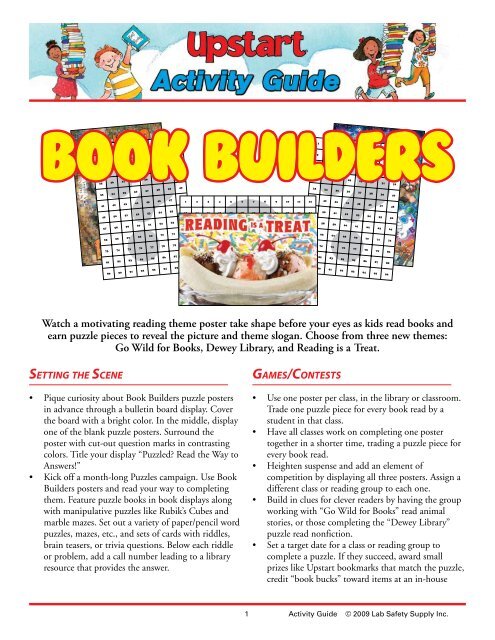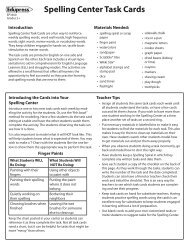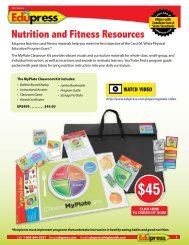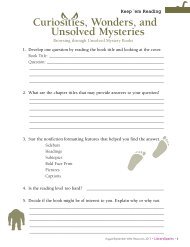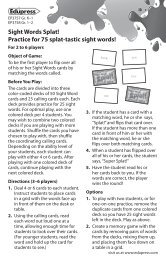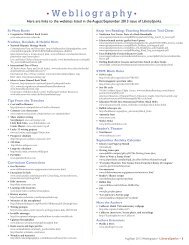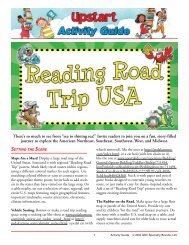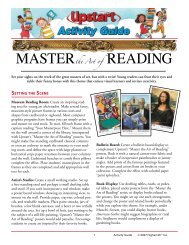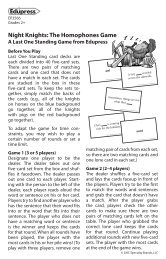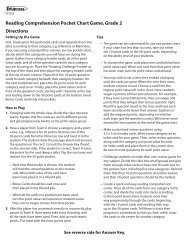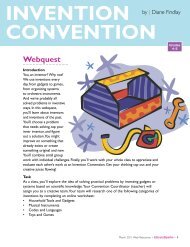books - Upstart Promotions
books - Upstart Promotions
books - Upstart Promotions
You also want an ePaper? Increase the reach of your titles
YUMPU automatically turns print PDFs into web optimized ePapers that Google loves.
H172805 upstartpromotions.com© Lab Safety Su ply Inc. 2 09H172804 upstartpromotions.com© Lab Safety Supply Inc. 2009H172805 upstartpromotions.com© Lab Safety Su ply Inc. 2 096 7 89 10 11 12 13 14 15 1617 18 19 20 21 22 23 2425 26 27 28 29 30 31 3233 34 35 36 37 38 39 4041 42 43 44 45 46 47 4849 50 51 52 53 54 55 5657 58 59 60 61 62 63 6465 66 67 68 69 70 71 7273 74 75 76 77 78 79 8081 82 83 84 85 86 87 8889 90 91 92 93 94 95 961 2 3 4 5 6 7 8 9 10 11 1213 14 15 16 17 18 19 20 21 22 23 2425 26 27 28 29 30 31 32 33 34 35 3637 38 39 40 41 42 43 44 45 46 47 4849 50 51 52 53 54 55 56 57 58 59 6061 62 63 64 65 66 67 68 69 70 71 7273 74 75 76 77 78 79 80 81 82 83 846 7 89 10 11 12 13 14 15 1617 18 19 20 21 22 23 2425 26 27 28 29 30 31 3233 34 35 36 37 38 39 4041 42 43 44 45 46 47 4849 50 51 52 53 54 55 5657 58 59 60 61 62 63 6465 66 67 68 69 70 71 7273 74 75 76 77 78 79 8081 82 83 84 85 86 87 8889 90 91 92 93 94 95 9685 86 87 88 89 90 91 92 93 94 95 96Watch a motivating reading theme poster take shape before your eyes as kids read <strong>books</strong> andearn puzzle pieces to reveal the picture and theme slogan. Choose from three new themes:Go Wild for Books, Dewey Library, and Reading is a Treat.Setting the Scene• Pique curiosity about Book Builders puzzle postersin advance through a bulletin board display. Coverthe board with a bright color. In the middle, displayone of the blank puzzle posters. Surround theposter with cut-out question marks in contrastingcolors. Title your display “Puzzled? Read the Way toAnswers!”• Kick off a month-long Puzzles campaign. Use BookBuilders posters and read your way to completingthem. Feature puzzle <strong>books</strong> in book displays alongwith manipulative puzzles like Rubik’s Cubes andmarble mazes. Set out a variety of paper/pencil wordpuzzles, mazes, etc., and sets of cards with riddles,brain teasers, or trivia questions. Below each riddleor problem, add a call number leading to a libraryresource that provides the answer.Games/Contests• Use one poster per class, in the library or classroom.Trade one puzzle piece for every book read by astudent in that class.• Have all classes work on completing one postertogether in a shorter time, trading a puzzle piece forevery book read.• Heighten suspense and add an element ofcompetition by displaying all three posters. Assign adifferent class or reading group to each one.• Build in clues for clever readers by having the groupworking with “Go Wild for Books” read animalstories, or those completing the “Dewey Library”puzzle read nonfiction.• Set a target date for a class or reading group tocomplete a puzzle. If they succeed, award smallprizes like <strong>Upstart</strong> bookmarks that match the puzzle,credit “book bucks” toward items at an in-house Activity Guide © 2009 Lab Safety Supply Inc.
Book Buildersbook fair, or opportunities to read aloud to the classfrom a favorite book or to choose a book for classdiscussion.• As a puzzle nears completion and the theme emerges,have kids suggest <strong>books</strong> that relate to the theme andbuild a class reading list around it.• Support differentiated instruction by using adifferent Book Builders puzzle for each leveledreading group. Groups will read <strong>books</strong> at theappropriate level. That way, they can “race” tocomplete their puzzles without an automaticdisadvantage for less-skilled readers or the built-inproblem of kids choosing <strong>books</strong> below their skilllevels for the sake of speed. You might develop listsof recommended titles for each reading level.• Exercise critical thinking skills with “chain” reading,in which each book leads to another related book.Readers choose their first book freely, but the nextbook must be by the same author, about the samesubject, a nonfiction parallel to fiction or vice versa,etc. Have kids bring you the just-read book and thenext choice, and explain the connection to you.• Engage skills other than reading proficiency bygiving kids different ways to be involved or “win.”• Hold a contest for kids to design additionalBook Builder puzzles, featuring original picturesand theme slogans. Entries should include arecommended reading list of at least three <strong>books</strong> thatrelate to the theme.• Invite kids to create their own puzzles out ofdrawings of the covers of their favorite <strong>books</strong>. Set thestudent-generated puzzles at a learning center or usethem to carry on the puzzle reading theme.• Check out <strong>Upstart</strong>’s “Read in the Wildest Places”online guide for activity or literature connectionsrelated to the “Go Wild for Books” puzzle.Kids Earn Puzzle Pieces by…• Reading a book• Turning in a short form for each book read, showingtitle, author, and something learned from the book• Increasing reading rate• Learning basic sight words• Being first to correctly identify the picture andtheme slogan as a puzzle takes shape• Being a “most improved reader” for a school term• Making a compelling book recommendation toclassmates• Completing a specific extension activity relatedto a book. You might design activities to addressparticular skills that need work, such as vocabularyor comprehension.Award Puzzle Pieces to Classes orReading Groups for…• Every five or ten <strong>books</strong> they read, collectively• Every five or ten <strong>books</strong> they check out of the library,collectively• Returning all library <strong>books</strong> on time• Checking out items that, collectively, representseveral different literary genres or formatsA Few Suggested “Puzzle” Titles• Can You See What I See? Dream Machine by WalterWick. Cartwheel, 2003. ISBN 0439399505. K–5.NOTE: Check out the whole Can You See What ISee? series.• Enigma: A Magical Mystery by Graeme Base. AbramsBooks for Young Readers, 2008. ISBN 081097245X.3–6.• I Spy: A Book of Picture Riddles by Jean Marzollo.Cartwheel, 2992. ISBN 0590450875. P–4. NOTE:See the whole I Spy series.• Imagine by Norman Messenger. Candlewick Press,2005. ISBN 0763627577. 2–5.• Mazeways by Roxie Munro. Sterling, 2007. ISBN1402737742. 1–4.• Puzzle Town by Susannah Leigh. EducationalDevelopment Corporation, 2003. ISBN0794504388. K–4. Part of the Usborne YoungPuzzle Books series.• The Puzzling World of Winston Breen by Eric Berlin.Puffin, 2009. ISBN 0142413887. 4–6. See also thesequel, The Potato Chip Puzzles.• The Warlord’s Puzzle by Virginia Walton Pilegard.Pelican Publishing Company, 2000. ISBN1565544951. K–4.2 Activity Guide © 2009 Lab Safety Supply Inc.
H172805 upstartpromotions.com© Lab Safety Su ply Inc. 2 09Book Builders: Go Wild for Books!Setting the SceneBulletin Board. Cover the board with wrapping paperor fabric in a pattern of zebra or tiger stripes or leopardspots. Cut black letters to title your display “Go Wild forBooks!” Cut out pictures of wild animals from magazinesor printed graphics. Back them with slightly larger blackconstruction paper silhouettes for contrast and attachthem to the board. Below each, tack a colorful cardwith the name of the animal, the DDC number whereinformation about it may be found, and the title andauthor of at least one book in your collection about it.1 2 3 4 5 6 7 89 10 11 12 13 14 15 1617 18 19 20 21 22 23 2425 26 27 28 29 30 31 3233 34 35 36 37 38 39 4041 42 43 44 45 46 47 4849 50 51 52 53 54 55 5657 58 59 60 61 62 63 6465 66 67 68 69 70 71 7273 74 75 76 77 78 79 8081 82 83 84 85 86 87 8889 90 91 92 93 94 95 96Art/Craft ProjectsWild Animal Bookmarks. Provide colorful wrappingpaper, bond, or card stock, crayons, markers, and glue.Have children draw and cut out animal shapes anddecorate them as personal bookmarks. They might be realanimals like coily snakes or fierce tigers, or fantasy animalsthat express a child’s wild side! “Laminate” the bookmarksbetween layers of clear contact paper to make them last.Critter Kinetic Sculpture.Find an interestingly shapedtree branch about a foot anda half long. Tie a length ofstring or twine to each end to make aninverted V hanger. Use green tissue paper to add leaveshere and there. Invite kids to draw and cut out smalljungle animal shapes, colored on front and back, to add toyour mobile. Birds or snakes can rest on the branch andmonkeys hang from it. Land animals can be suspendedbelow. You could make a cardboard trunk with severalbranches to accommodate a big group. Alternatively,provide other craft materials like empty spools, craftsticks, straws, pipe cleaners, cardboard tubes… and seehow creative the kids can be.© Lab Safety Supply Inc. 2009H172825 upstartpromotions.comLanguage Arts Projects“And I’m Not Lion . . . ” Talk about tall tales—humorous stories that use wild exaggeration to bragabout the accomplishments and abilities of the storytelleror the subject of the story. Then try a cumulative talltale about a laughable lion singing his own praises. Startsomething like this: “Hi! I’m Lorenzo the Lion, here totell you about all the heroic things I did today—and I’mnot ‘lion!’ It all started this morning, when I woke up tomy phone ringing. It was my neighbor, Rory the Rabbit,so frightened he could hardly speak! It seemed that apesky hawk kept swooping past his burrow, scaring himand his family. Now, I have nothing against hawks ingeneral, but I won’t stand for anyone threatening myneighbors! So I stalked out of my den and with onemighty ROOARR, I terrified that old hawk ‘way intonext week! Then…” invite kids to continue the storywith another adventure starring the lion in super-felinefeats of heroism. Try this with a variety of animals fromdifferent habitats for a fun exercise in wild imagination.Animal Authors. Read Judy Sierra’s Wild about Books.Have kids choose one of the animal authors in the book,and imagine themselves as that animal. They will writeshort stories from the animal author’s point of view,about its life and adventures. Illustrate the stories andcombine them into an animal anthology. Activity Guide © 2009 Lab Safety Supply Inc.
Book Builders: Go Wild for Books!Math/Science ActivitiesPredator/Prey Matching. Check out this TeacherVisionWeb site printable: www.teachervision.fen.com/tv/printables/orange/sl-102.pdf. Print and use it as is, ortreat it as a template and make several similar matchingactivity sheets featuring different prey animals and theirpredators.Endangered Species Math. Visit www.endangeredspecie.com/map.htm and click on the map for your state. Workwith children to determine the number of endangeredspecies in your state, and how many are in each category:Vulnerable, Threatened, Endangered, or XN: Extinct.Express each category as a percent, fraction, or decimalnumber of the whole. Make up word problems based onthe information, like “How many more animal speciesare threatened than endangered in our state?” Createa bar graph showing the number of animals in eachcategory and illustrate it with a picture of an animalin that category. NOTE: This site may not be currentbeyond 2002. For more up-to-date information, try akeyword search of your state and “endangered species.”Internet ActivityAnimal Planet’s Top 100 Wild Animals. Bookmarkthis site, http://animal.discovery.com/tv/wild-100/guide/guide.html, and let kids scroll through the results of a2007 poll of America’s favorite wild animals. Click onany animal in the countdown to see a beautiful, fullcolorphoto, basic facts, and a “Did You Know” fun fact.“Go Wild” Reading• 1-2-3 Draw Cartoon Wildlife by Steve Barr. PeelProductions, Inc., 2003. ISBN 0939217708. 2–5.• Akimbo and the Elephants by Alexander McCallSmith. Bloomsbury USA Children’s Books, 2007.ISBN 1599900319. 3–5. Check out the wholeAkimbo series.• The Chimpanzees I Love: Saving Their World andOurs by Jane Goodall. Scholastic, 2001. ISBN043921310X. 3–6.• Finding Home by Sandra Markle. CharlesbridgePublishing, Inc., 2008. ISBN 1580891225. 1–4.• Gorilla! Gorilla! by Jeanne Willis. Atheneum, 2006.ISBN 1416914900. P–3.• Mama’s Wild Child, Papa’s Wild Child: A Flip-meoverBook by Dianna Hutts Aston. CharlesbridgePublishing, Inc., 2006. ISBN 1570915903. P–3.• Tooth and Claw: Animal Adventures in the Wildby Ted Lewin. HarperCollins, 2003. ISBN0688141056. 3–6.• Wild about Books by Judy Sierra, illustrated by MarcBrown. Knopf Books for Young Readers, 2004.ISBN 037582538X. K–3. Activity Guide © 2009 Lab Safety Supply Inc.
Book Builders: Dewey LibraryInternet ActivityDewey Browsing Online. Help children orientthemselves to the logic and structure of the DDCusing www.deweybrowse.org. Make up worksheets withseveral specific tasks or individual task cards and setthem at a computer station with the Dewey Browsesite bookmarked. The site isn’t comprehensive; rather,it offers a smattering of links to interestingsites addressing topics within in eachDewey hundreds category. Prepare yourtasks to tap resources available throughthe site. You might offer a hint below eachquestion or on the back of each card. Forexample, have kids look for a picture ofKing Arthur, with a “300s” hint; or arhyme for the word “grammar”, with alead to the “400s.”H172826 upstartpromotions.com© Lab Safety Supply Inc. 2009“Dewey Library” Books• Amelia Bedelia, Bookworm by Herman Parish.HarperCollins, 2003. ISBN 0060518901. 1–3.• Book Fair Day by Lynn Plourde. Puffin, 2008. ISBN0142411396. K–3.• Here Lies the Librarian by Richard Peck. Puffin,2007. ISBN 0142409081. 5+.• The Legend of Spud Murphy by Eoin Colfer. San Val,2005. ISBN 1417698764. 2–4.• Library Lil by Suzanne Williams. Puffin, 2001. ISBN0140568379. K–3.• The Penultimate Peril (A Series of Unfortunate Events#12) by Lemony Snicket. HarperCollins, 2005.ISBN 0064410153. 4–6.• The Storyteller’s Candle/La Velita de los Cuentosby Lucia Gonzalez. Children’s Book Press, 2008(Bilingual edition). ISBN 0892392223. 1–4.• What Marion Taught Willis by Brook Berg. <strong>Upstart</strong>Books, 2005. ISBN 1932146334. 1–3. Activity Guide © 2009 Lab Safety Supply Inc.
H172804 upstartpromotions.com© Lab Safety Su ply Inc. 2 09Book Builders: Reading is a TreatSetting the SceneBulletin Board. Use red and white-striped or candypatternedwrapping paper for the background andcreate a border of “Reading is a Treat” bookmarks, orcut out ice cream cones, gingerbread children, or candycanes. Add a “Reading is a Treat!” heading. Announceupcoming activities on large pastel cardstock “candyhearts.” Post a booklist of titles from your collectionrelated to sweet treats, with appropriate book jackets andsimple recipes kids can make.Jigsaw Puzzles. Find a few jigsaw puzzles featuringice cream, candy, or baked goods. Provide puzzles atdifferent levels of difficulty. Set them up on puzzle tableswith a few pieces assembled to entice kids to work onthem when they visit the library or between classroomtasks.1 2 3 4 5 6 7 8 9 10 11 1213 14 15 16 17 18 19 20 21 22 23 2425 26 27 28 29 30 31 32 33 34 35 3637 38 39 40 41 42 43 44 45 46 47 4849 50 51 52 53 54 55 56 57 58 59 6061 62 63 64 65 66 67 68 69 70 71 7273 74 75 76 77 78 79 80 81 82 83 8485 86 87 88 89 90 91 92 93 94 95 96Writing ProjectsPoetic Tributes to Good Taste. Scrumptious treats cansend us into raptures that can only be conveyed in verse!Invite kids to create poetic tributes to their favorite treats.Introduce specific forms of poetry, like odes or concretepoems, or let kids structure their poems as they wish.Anagrams. Anagrams are words made by selecting andrearranging letters found in source words. Post a longsource word related to sweets, like chocolate, marzipan,jawbreaker, sugarcane, caramelize, etc. See how manywords kids can make by choosing and rearranging lettersin the source word. They might work individually on theirown paper, or add words to a group list.Math/Science ActivitiesSweet Scents.Gather samples ofsweet treats withdistinctive smells,like chocolate, candyorange slices, black licorice, peppermints, or differentkinds of cookies. Put each in its own small paper bag,hidden from sight. Have children close their eyes and seehow many they can identify by scent alone.Candy Calculations. Distribute 25-30 small candies(jelly beans, M&M’s, etc.) to each child. Write simplearithmetic problems on a board or easel and havechildren set them up and solve them using their candies.Practice addition, subtraction, multiplication, division,or simple fractions. When you’re done, enjoy your treats!Internet ActivityCandy Wordsearch. Bookmark this site and have kidssee how quickly they can find the candy names on thegrid: www.carriescandies.com/candywordsearch.html.“Reading is a Treat” Resources• The Candy Shop War by Brandon Mull. ShadowMountain, 2007. ISBN 159038783X. 4–6.• Charlie and the Chocolate Factory by Roald Dahl,adapted by Richard R. George. Penguin Group,2007. ISBN 0142407909. 3–6.• The Chocolate Touch by Patrick Skene Catling.HarperCollins, 2006. ISBN 0688161332. 2–4.• Chocolates and Candies to Make by Rebecca Gilpinand Catherine Atkinson. Usborne Books, 2006.ISBN 0794508235. 1–4.• How Sweet It Is (and Was): The History of Candy byRuth Freeman Swain. Holiday House, 2003. ISBN0823417123. 1–4. Activity Guide © 2009 Lab Safety Supply Inc.
Book Builders: Reading is a Treat• Ice–Cream Cones for Sale by Elaine Greenstein.Arthur A. Levine Books, 2003. ISBN 0439327288.K–3.• Minnie and Moo: The Case of the Missing Jelly Donutby Denys Cazet. HarperCollins, 2006. ISBN0060730099. 1–3.• Mrs. Biddlebox by Linda Smith. Harcourt Children’sBooks, 2007. ISBN 0152063498. K–4. Activity Guide © 2009 Lab Safety Supply Inc.
In Melvil’s HeadSee page 5 for instructions.9 Activity Guide © 2009 Lab Safety Supply Inc.


